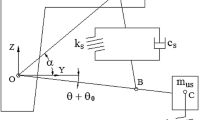Abstract
The dynamic performance of railway vehicle is normally expressed as stability, safety and ride comfort, and is affected by mass properties, suspension characteristics, contact mechanism between a wheel and a rail, etc. This paper describes the procedure of sensitivity analysis between some of the suspension characteristics of the Korean high speed train (KHST) as the design variables and the dynamic performance as the response variables; and it analyzes the results of sensitivity characteristics for the design variables, comparing two different approximated approach processes known as the response surface model formulated in a polynomial equation and neural network model formulated in a processing code. Analyzing the suspension characteristics for KHST, the approximated method creating meta-models consisted of 29 design variables and 46 performance indexes, which are applied in this paper. The models were coded by using the correlation information between the design variables and the performance indexes made by the 66 times iterative simulations according to the design of experimental method. The table consists of the orthogonal array L32 and the D-Optimal design table. The results show that the proposed sensitivity analysis procedure is very efficient and simply applicable for a complex mechanical system such as railway vehicle system. Also they show that the two models applied in this paper have similar tendency in the view of the sensitivity order of the design variables.
Similar content being viewed by others
References
R. V. Dukkipati and J. R. Amyot, Computer-Aided Simulation in Railway Dynamics. MARCEL DEKKER Inc., (1988).
C. K. Park and K. K. Lee, Optimization of the elastic joint of train bogie using by response surface model. Korean Society of Mechanical Engineers, 24(3) (2000) 661–666.
Y. G. Kim, C. K. Park, H. S. Hwang and T. W. Park, Design Optimization for Suspension System of High Speed Train Using Neural Network, JSME International Journal Series C, 46(2), (2003) 727–735.
D. C. Montgomery, Design and Analysis of Experiments, 4th Edition, John Wiley & Sons, Inc, (1997).
Author information
Authors and Affiliations
Corresponding author
Additional information
ChanKyoung Park received B.S., M.S., and Ph.D. degrees in Mechanical Engineering from Hanyang University in 1987, 1989, and 2004, respectively. Dr. Park is currently a Principal Researcher at the Korea Railroad Research Institute in Euwang, Korea. His research interests are in the area of high speed train dynamics and system engineering of trains.
Rights and permissions
About this article
Cite this article
Park, C., Kim, Y. & Bae, D. Sensitivity analysis of suspension characteristics for Korean high speed train. J Mech Sci Technol 23, 938–941 (2009). https://doi.org/10.1007/s12206-009-0316-5
Received:
Revised:
Accepted:
Published:
Issue Date:
DOI: https://doi.org/10.1007/s12206-009-0316-5




